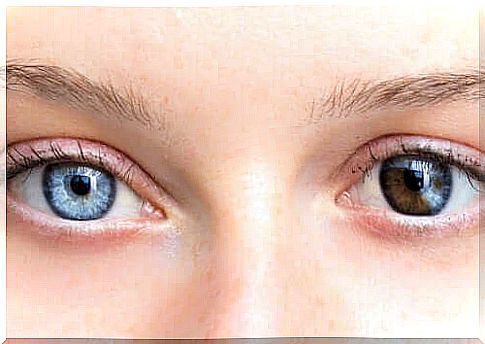Change In Eye Color Due To Illnesses
If the color of the iris changes, you have to go to a specialist doctor for an examination. Find out interesting facts about possible causes today.

The change in eye color is a relatively rare phenomenon, but it must be interpreted as a warning sign. The eyes are very attractive and expressive and are the focus of every communication. However, they can also provide important information about health.
If you observe a change in eye color , you definitely need to see a specialist in order to receive a diagnosis and, if necessary, initiate the right treatment.
In today’s article you will learn interesting facts about possible causes that can lead to a change in the color of the iris.
Diseases that lead to changes in the color of the eyes
At birth, the color of the eyes is usually gray-blue. But it changes over time until it reaches its final color. In the first months of life, the change in the color of the iris is quite normal. The development of pigmentation is not yet complete. Within the first year of life, the eye forms pigments that ultimately give the child the final eye color.
However, if the color of the iris changes in adulthood, it can be a warning sign of illness. In many cases, it is a symptom of one of the pathologies that we will describe in more detail below.
Changes in eye color due to pigment spots
Before we go into more detail about color changes caused by pigment spots (naevi), let’s briefly explain how the color pigment melanin works. This endogenous pigment is present in both the skin and the iris. It also determines the color of our hair.
Specialized cells called melanocytes produce this color pigment. These cells can be found in the skin and in the eyes and this explains exactly why pigment spots can also develop in the eyes. These are very similar to those that appear on the skin. Usually these are benign growths of cells that produce melanin.
These pigment spots can appear at any age. It is one of the most common causes of eye color changes.
Even if these are mostly benign pigment spots, these can sometimes develop into malignant melanoma. It is a tumor that affects vision.
A study published in the journal Recent Results in Cancer Research found it to be a very rare type of cancer that is estimated to develop around 2,000 people annually in the United States.

Lisch nodules
We are talking about pigment accumulations on the iris of the eye, which are benign and can reach a size of 1 to 2 ml.
An article published in the journal Revista Méxicana de Oftalmología indicates that in most cases this is a symptom of neurofibromatosis. This disease is genetic and leads to the formation of neoplasms. Affected patients develop neurofibromas that arise from the supporting tissue of the peripheral nervous system and are usually benign. However, in rare cases they can also develop malignantly.
It is a disease that is usually diagnosed in childhood. As with the pigment spots in the eyes that we have already mentioned, the small, rounded and sharply defined Lisch nodules lead to changes in the iris.
Fuchs heterochromic iridocyclitis
The Fuchs heterochromic iridocyclitis (also Fuchs syndrome III) occurs very rarely. This is a color difference between the left and right eye, which, according to information from the Orphanet platform, affects between 1 and 9 people per 1 million people. It usually happens in young adults, who subsequently change the color of their eyes.
The color of the iris of one eye becomes lighter than that of the other eye. The reasons for this are unknown, but the magazine Revista de la Sociedad Colombiana de Oftalmología , for example, points out that there may be a connection with the herpes simplex virus, the rubella virus or herpes zoster.
The problem with this disease is that it can also trigger symptoms such as myodesopsias. These are small floating bodies inside the eye that are perceived as spots in the field of vision and are also known as “floating flies” because they cast shadows on the retina. This could also lead to glaucoma or cataracts.
Iridocorneal Endothelial Syndrome (ICE Syndrome) and changes in eye color
The ICE syndrome leads to swelling of the cornea and the progressive proliferation of the endothelium. This can also lead to glaucoma. An indication of this is the change in eye color. However, it is a rare disease.
When certain cells migrate from the cornea to the iris, deformation of the iris and pupil occurs. It also affects the normal circulation of eye fluid. This then builds up in the eye, which in turn increases intraocular pressure and can lead to glaucoma. The most common symptoms in this case are blurred vision, a change in the color of the iris and sometimes pain.
Pigment dispersion syndrome (PDS) and changes in eye color
Usually, the pigment cells that give the iris its color are right on the back. In some people, however, these cells become detached and move around in the aqueous humor. These cells can also build up and block the drainage of aqueous humor. The intraocular pressure increases permanently, which can lead to glaucoma. Another consequence is changes in the color of the iris.

Changed eye color due to injuries
Trauma is also one of the most common causes of changed eye color. For example, it could be an injury from a sharp object, bruises, or burns. When a blood vessel in the eye is injured, hyposphagma occurs, a subconjunctival hemorrhage that affects vision. This can lead to double vision or increased sensitivity to light, for example.
Any change in eye color should definitely be examined by a specialist
If the color of the iris changes, be sure to see a specialist for an exam. Because you now know that there could be a disease hidden behind it that should be treated as soon as possible. There is also a risk of vision loss.
If you have any doubts or if you yourself observe changes in yourself or in another person, it is best to go to the ophthalmologist as soon as possible, who can examine and advise you. The eyes are sensitive and always need proper care.









